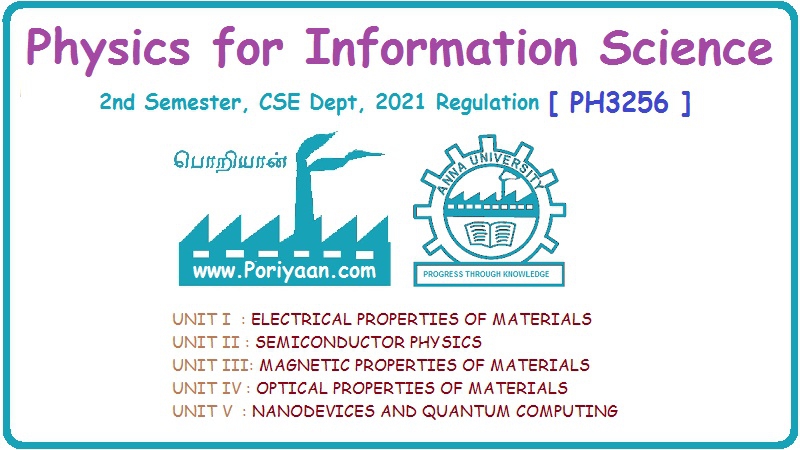Physics for Information Science: Unit IV: Optical Properties of Materials
Light Emitting Diode (LED)
Definition, Types, Construction, Working Principle, Advantages, Disadvantage
LED is a semiconductor p-n junction diode which converts electrical energy to light energy under forward biasing. It emits light in both visible and IR region.
LIGHT
EMITTING DIODE (LED)
Definition
LED
is a semiconductor p-n junction diode which converts electrical energy to light
energy under forward biasing. It emits light in both visible and IR region.
Types of LED
There
are two types of LED. viz.,
(i)
Planar (or) Surface emitting LED and
(ii)
Dome shaped LED.
Let
us discuss in detail about the planar (or) surface emitting LED.
Principle
Injection
luminescence is the principle used in both the LED's. When LED is forward
biased, the majority charge carriers moves from p to n and similarly from n to
p region and becomes excess minority carriers. Then these excess minority
charge carriers diffuses through the junction and recombines with the majority
charge carriers in n and p region respectively to produce light.
Construction
The
surface emitting LED is as shown in Fig. 4.20. Here the p-n junction is formed
by diffusion or epitaxial techniques. The p-n junction is made by doping
silicon with GaAs crystal. Since silicon can act both as donar (when it
replaces Gallium) and acceptor (when it replaces arsenide) it is used as the
impurity atom (or) dopent. Therefore a shallow p-n junction is formed on GaAs
substrate such that p-layer is formed by diffusion on 'n' layer.
In
order to increase the probability of radiative recombination, the thickness of
the 'n' layer is taken higher than that of the thickness of the 'p' layer.
Ohmic
contacts are made with the help of aluminium in such a way that top layer of
the 'p' material is left uncovered, for the emission of light. Proper biasing
can be applied at the ohmic contacts. The whole p-n junction is surrounded by
plastic material so that the losses due to reflection can be minimised.
Working
The
diode is forward biased. Due to forward bias, the majority charge carriers from
'n' and 'p' regions cross the junction and become minority charge carriers in
the other junction (i.e) Electrons, which are majority charge carriers in 'n'
region cross the junction and go to 'p' region and become minority charge
carriers in p-region as shown in Fig. 4.21.
Similarly,
holes which are majority charge carries in 'p' region cross the junction and go
to 'n' region and become minority charge carriers in 'n' region.
By
the similar process, excess of minority carriers (shaded electrons and holes)
are injected in both 'p' and 'n' regions as shown in Fig. 4.21 and this
phenomenon is called minority carrier injection.
Now
if the biasing voltage is further increased, these excess minority carriers
diffuse away from the junction and they directly recombine with the majority
carriers. (i.e.) the electrons, which are excess minority carriers in p-region
recombine with the holes which are the majority carriers in 'p' region and emit
light. Similarly, the holes which are excess minority carriers in 'n' region
recombine with the electrons which are majority carriers in 'n' region and emit
light.
Therefore
electron-hole recombination process occurs more and more and thereby light
(photons) is emitted through the top layer of the p-material which is left
uncovered as shown in Fig. 4.20.
Advantages
(i)
They are smaller in size.
(ii)
Its cost is very low.
(iii)
It has long life time.
(iv)
LED's are available in different colours at low cost.
(v)
It operates even at very low voltage.
(vi)
Response time of LED is very fast, in the order of 10-9 seconds.
(vii)
Its intensity can be controlled easily.
(viii)
It can be operated at a wide range of temperatures (0 - 70°C).
(ix)
Dome shaped LED has less scattering losses.
Disadvantages
(i)
Power output is low.
(ii)
Intensity is less than laser.
(iii)
The light cannot travel through longer distance.
(iv)
The light output is incoherent and are not in phase.
(v)
The light will not have directionality.
Physics for Information Science: Unit IV: Optical Properties of Materials : Tag: : Definition, Types, Construction, Working Principle, Advantages, Disadvantage - Light Emitting Diode (LED)
Related Topics
Related Subjects
Physics for Information Science
PH3256 2nd Semester CSE Dept | 2021 Regulation | 2nd Semester CSE Dept 2021 Regulation
